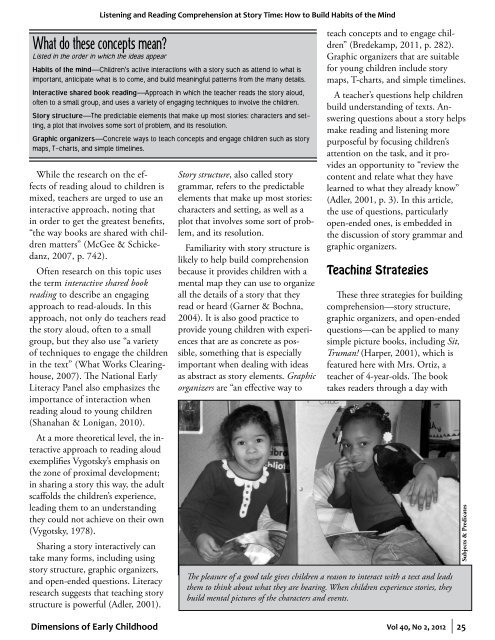Water Play - Southern Early Childhood Association
Water Play - Southern Early Childhood Association
Water Play - Southern Early Childhood Association
Create successful ePaper yourself
Turn your PDF publications into a flip-book with our unique Google optimized e-Paper software.
Listening and Reading Comprehension at Story Time: How to Build Habits of the Mind<br />
What do these concepts mean?<br />
Listed in the order in which the ideas appear<br />
Habits of the mind—Children’s active interactions with a story such as attend to what is<br />
important, anticipate what is to come, and build meaningful patterns from the many details.<br />
Interactive shared book reading—Approach in which the teacher reads the story aloud,<br />
often to a small group, and uses a variety of engaging techniques to involve the children.<br />
Story structure—The predictable elements that make up most stories: characters and setting,<br />
a plot that involves some sort of problem, and its resolution.<br />
Graphic organizers—Concrete ways to teach concepts and engage children such as story<br />
maps, T-charts, and simple timelines.<br />
While the research on the effects<br />
of reading aloud to children is<br />
mixed, teachers are urged to use an<br />
interactive approach, noting that<br />
in order to get the greatest benefits,<br />
“the way books are shared with children<br />
matters” (McGee & Schickedanz,<br />
2007, p. 742).<br />
Often research on this topic uses<br />
the term interactive shared book<br />
reading to describe an engaging<br />
approach to read-alouds. In this<br />
approach, not only do teachers read<br />
the story aloud, often to a small<br />
group, but they also use “a variety<br />
of techniques to engage the children<br />
in the text” (What Works Clearinghouse,<br />
2007). The National <strong>Early</strong><br />
Literacy Panel also emphasizes the<br />
importance of interaction when<br />
reading aloud to young children<br />
(Shanahan & Lonigan, 2010).<br />
At a more theoretical level, the interactive<br />
approach to reading aloud<br />
exemplifies Vygotsky’s emphasis on<br />
the zone of proximal development;<br />
in sharing a story this way, the adult<br />
scaffolds the children’s experience,<br />
leading them to an understanding<br />
they could not achieve on their own<br />
(Vygotsky, 1978).<br />
Sharing a story interactively can<br />
take many forms, including using<br />
story structure, graphic organizers,<br />
and open-ended questions. Literacy<br />
research suggests that teaching story<br />
structure is powerful (Adler, 2001).<br />
Story structure, also called story<br />
grammar, refers to the predictable<br />
elements that make up most stories:<br />
characters and setting, as well as a<br />
plot that involves some sort of problem,<br />
and its resolution.<br />
Familiarity with story structure is<br />
likely to help build comprehension<br />
because it provides children with a<br />
mental map they can use to organize<br />
all the details of a story that they<br />
read or heard (Garner & Bochna,<br />
2004). It is also good practice to<br />
provide young children with experiences<br />
that are as concrete as possible,<br />
something that is especially<br />
important when dealing with ideas<br />
as abstract as story elements. Graphic<br />
organizers are “an effective way to<br />
teach concepts and to engage children”<br />
(Bredekamp, 2011, p. 282).<br />
Graphic organizers that are suitable<br />
for young children include story<br />
maps, T-charts, and simple timelines.<br />
A teacher’s questions help children<br />
build understanding of texts. Answering<br />
questions about a story helps<br />
make reading and listening more<br />
purposeful by focusing children’s<br />
attention on the task, and it provides<br />
an opportunity to “review the<br />
content and relate what they have<br />
learned to what they already know”<br />
(Adler, 2001, p. 3). In this article,<br />
the use of questions, particularly<br />
open-ended ones, is embedded in<br />
the discussion of story grammar and<br />
graphic organizers.<br />
Teaching Strategies<br />
These three strategies for building<br />
comprehension—story structure,<br />
graphic organizers, and open-ended<br />
questions—can be applied to many<br />
simple picture books, including Sit,<br />
Truman! (Harper, 2001), which is<br />
featured here with Mrs. Ortiz, a<br />
teacher of 4-year-olds. The book<br />
takes readers through a day with<br />
The pleasure of a good tale gives children a reason to interact with a text and leads<br />
them to think about what they are hearing. When children experience stories, they<br />
build mental pictures of the characters and events.<br />
Dimensions of <strong>Early</strong> <strong>Childhood</strong> Vol 40, No 2, 2012 25<br />
Subjects & Predicates
















